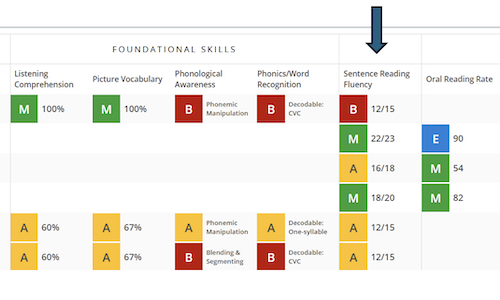 When two education leaders join forces to tackle teachers’ toughest questions, the result isn’t just more answers—it’s also a closer look at how one personalized learning platform is turning insights into action.
When two education leaders join forces to tackle teachers’ toughest questions, the result isn’t just more answers—it’s also a closer look at how one personalized learning platform is turning insights into action.
And we’re talking about timeless teacher questions, such as:
- “How do I support a wide variety of learners, ranging in skill levels, learning styles, and personalities?”
- “What do I do when I’m unsure of a learner’s readiness?”
- “How do I engage each and every student, wherever they are on their learning journey?”
- “How can I apply assessment data to classroom instruction?”
- “What is my next step, today?”
Whether you’re a first-year teacher or a seasoned veteran, if you’re in the classroom, you’ve asked these questions. Why? Because teachers face a near-impossible mission: meeting every student’s needs—without magic, cloning, or a NASA-level support team.
Many solutions fall short because what works for one learner doesn’t always work for another. That’s why when, during a recent webinar, my colleague Lindsay Edmonson said, “This isn’t one-size-fits-all learning. This is growth-in-motion for every student,” I leaned in.
Let’s recap some important highlights from the webinar that you can keep in mind as you watch on demand.
It’s a dream team thing
Here’s the thing about the NWEA MAP® Growth™ assessment: it’s one of the most trusted, reliable, and actionable assessments on the market. So when an assessment like that is paired with HMH’s expertise on delivering high-quality instructional content, the two offer a uniquely powerful personalized learning platform that supports all tiers of MTSS solutions, is easy for teachers to use, and keeps students engaged: Personalized Path.
Lindsay kicked off the 45-minute webinar with an introduction to HMH Ed Dashboard, the digital landing place for HMH curriculum, and previewed 2026 back-to-school functionality that will allow for direct access to MAP Growth testing sessions. This access will allow educators to set up accommodations and generate reports without leaving the platform. This means teachers will have an integrated assessment and instructional platform.
Let me restate this in Teacher Speak: No more different links. No more passwords. No more session names. No more looking at reports and wondering what Jamie, Jose, or Sarah needs, and did I remember to print it out?
Adaptive practice: AI that differentiates
Teachers well-versed in MTSS systems know the importance of practice. We know that intentional, targeted practice can be a real game changer in a student’s learning journey. The tricky part is providing the just-right practice for every learner, and this is where assessment data becomes crucial: What is the latest data telling me about what this learner needs, now?
Lindsay walked through the AI-driven adaptive practice within Personalized Path, which is directly influenced by students’ latest assessment data. Instead of simply cataloging correct and incorrect answers, the machine-learning technology analyzes the “whys” behind an incorrect answer (such as missing prerequisite skills) and supplies new questions that dig deeper into diagnosing, reviewing, and strengthening the necessary stair steps to get students where they need to be.
As a teacher, here’s what I heard: “I don’t have to be an expert in the previous year’s spiraling math or reading skills, or remember what this student needed two weeks ago, or pinpoint exactly how to challenge this child, today. I can have some help!”
Want to feel as relaxed as I did? Head to minute 13:30 of the webinar.
Tailored intervention: Supporting our Tier 2 and 3 students
Say you’ve got a seventh-grader who needs first-grade reading support. This 12-year-old needs practice with decoding that isn’t designed for a six-year-old. What do you do? No “baby books” here! As Lindsay says, “If you haven’t seen Read 180® in the past few years, I highly recommend checking it out. She’s had a glow up.”
For those MTSS Tier 2 and 3 students who are receiving additional instruction and support from the school, independent or resource time is hugely enriched with HMH Ed’s tailored intervention. Lindsay showed off Read 180 Flex, which has been redesigned to include a new foundational skills curriculum—including a new writing strand—to ensure students who need phonics and decoding help aren’t left out. Read 180 Flex is flexible, engaging, and attractive, and it aligns with MAP Growth RIT scores to determine where students begin their own pathways. Older learners, who are so often left behind if they outgrow the materials while still working on mastering the skillsets, get what they need in a sophisticated, relevant personalized learning platform.
Want to see the Read 180 solution? Reach out to your account representative.
One location, one reports tab
Teachers, check this out: whether you’re looking for MAP Growth assessment data or progress monitoring support with Read 180, you have access to readable, actionable data on the HMH Ed Dashboard. One click. All reports. Actionable data. And answers to questions like:
- How many minutes is Josie spending in Reading 180?
- Why is Eliza seeing this practice pathway?
- What are the current achievement percentiles for my class?
- Which students might need my attention, today?
- As I select an appropriate book for Joey, which Lexile range should I aim for?
Want to see a preview of how these reports look? Head to minute 32 of the webinar.
“It takes the teacher guesswork out of it”
As Lindsay was answering the lively and specific questions that came in through the chat—rostering, legacy reports, LMS integration—she elevated the main point: the new design is meant to simplify the teacher experience. One thing the NWEA and HMH power couple is aware of? Data should seamlessly enhance instruction, and instruction should be alive, evolving, informed, and engaging. Because student engagement is what actually leads to student outcomes.
Oh, and we should have one login for assessment and for practice. Because less friction means faster flying.
If you’re already an NWEA or HMH user and you have specific questions, be sure to especially check out the latter half of the webinar, where the chat was full of inquiry and response. And if you’re ready for a conversation about how you can get started with this powerful personalized learning platform, reach out to us.






